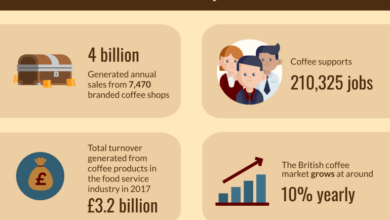
Turning a Sweet Passion into a Sweeter Career
Turning a sweet passion into an even sweeter career is a journey filled with exciting possibilities. Imagine transforming your love for baking, crafting, or writing into a fulfilling and profitable venture. This guide will walk you through the steps, from identifying your unique passion to scaling your business and maintaining that initial spark. We’ll explore how to assess marketability, craft a winning business plan, build a powerful brand, and master effective marketing strategies.
The path to turning a hobby into a thriving career isn’t always straightforward. It requires meticulous planning, a deep understanding of your target audience, and the resilience to overcome challenges. This exploration will provide you with the knowledge and tools to navigate this exciting transition.
Identifying the Passion
Turning a sweet passion into a thriving career requires a deep understanding of what truly drives you. It’s not enough to simply enjoy an activity; a fulfilling career passion requires a deeper connection, a sense of purpose, and a willingness to invest time and energy. This exploration will help you distinguish between a hobby and a career-worthy passion.Discovering and nurturing your passion is a journey of self-discovery, not a destination.
It’s about recognizing the activities that ignite your enthusiasm, evoke a sense of flow, and leave you feeling fulfilled, even when challenges arise.
Examples of Sweet Passions
Sweet passions encompass a wide range of creative and culinary pursuits. Baking, with its intricate techniques and delectable results, can be a source of immense satisfaction. Crafting, from knitting and sewing to woodworking and jewelry making, allows for unique expression and the creation of tangible objects. Writing, whether poetry, fiction, or articles, provides a platform for self-expression and connection with others.
These are just a few examples; the possibilities are vast and varied.
Characteristics of a Fulfilling Passion
A truly fulfilling passion possesses certain characteristics that distinguish it from a mere hobby. It’s characterized by intrinsic motivation, a deep sense of engagement, and the ability to generate a sense of flow. A passionate pursuit should not feel like a chore but rather an energizing experience that fuels your creativity and pushes your boundaries. A passion is not something you do simply for enjoyment but something that propels you to learn, grow, and contribute.
Distinguishing Between a Hobby and a Passion
A hobby is often a leisure activity, enjoyed for relaxation and personal enrichment. A passion, however, is a driving force that motivates you to learn, grow, and potentially build a career. A hobby might be enjoyed sporadically, while a passion is an integral part of your identity, constantly pushing you to improve and expand your skills. Key indicators include a willingness to invest time and effort in mastering the skill, a desire to learn and innovate, and a willingness to overcome challenges.
Questionnaire for Pinpointing Personal Passions
This questionnaire can help you identify personal passions suitable for a career:
- What activities do you find yourself consistently drawn to, even when time is limited?
- What tasks make you lose track of time, and do you feel a sense of accomplishment after completing them?
- Are there areas where you excel or have a unique perspective, and do you feel a sense of purpose in sharing that expertise?
- What skills do you enjoy practicing, and do you feel a genuine desire to learn and improve those skills?
- What activities generate a feeling of flow and enjoyment, even during challenging moments?
Potential Career Paths from Sweet Passions
Your sweet passions can translate into various rewarding career paths. A love for baking can lead to a career as a pastry chef, baker, food blogger, or even a cookbook author. A passion for crafting could lead to a career as a designer, artisan, or even a retailer specializing in handmade goods. A love for writing can pave the way for a career as a writer, journalist, editor, or even a novelist.
| Passion | Potential Career Paths |
|---|---|
| Baking | Pastry Chef, Baker, Food Blogger, Cookbook Author, Food Stylist |
| Crafting | Designer, Artisan, Retailer, Product Developer, Workshop Instructor |
| Writing | Writer, Journalist, Editor, Novelist, Content Creator, Copywriter |
Assessing Marketability

Turning a sweet passion into a profitable career requires a keen understanding of the market. Simply loving baking or crafting isn’t enough; you need to assess the potential demand for your products or services. This involves a careful examination of several factors, including the current market trends, your target audience, and the financial viability of your proposed business model.
This crucial step allows you to adapt your passion to the demands of the market, increasing your chances of success.Understanding the market is like navigating a complex maze. You need a roadmap to identify the paths that lead to profitability. The following sections will guide you through the process of evaluating the marketability of your sweet passion, helping you craft a business strategy that resonates with your target audience and ensures financial sustainability.
Factors Influencing Marketability
Several key factors influence the marketability of a sweet passion-based career. These factors range from the unique selling proposition of your offerings to the overall market trends. Understanding these factors is essential for adapting your passion to meet market demands and build a successful business.
- Market Trends: Staying updated on current trends in the food and beverage industry is critical. Are gourmet treats experiencing a resurgence? Are consumers seeking healthier, more sustainable options? Knowing these trends can help you tailor your products to align with the current market preferences. For instance, if you’re a baker, knowing the rising demand for vegan or gluten-free options allows you to cater to this niche market.
- Competition Analysis: Understanding your competition is vital. What are their strengths and weaknesses? What unique selling propositions do they offer? By analyzing your competitors, you can identify gaps in the market and develop a strategy to differentiate your offerings. A strong competitor analysis can reveal opportunities to provide better value, service, or unique flavors to attract customers.
- Uniqueness and Value Proposition: What makes your products or services stand out? Is it the unique flavor combinations, the exquisite presentation, or the sustainable sourcing of ingredients? Clearly defining your unique value proposition is crucial for attracting and retaining customers. For example, a handmade soap maker could highlight the use of locally sourced herbs and essential oils, differentiating themselves from mass-produced products.
Understanding Target Audiences
Knowing your target audience is fundamental to success. A deep understanding of their preferences, needs, and buying habits allows you to tailor your products or services to resonate with them.
- Identifying Ideal Customers: Who are your ideal customers? What are their demographics, interests, and lifestyle choices? Identifying these characteristics allows you to craft marketing messages that directly appeal to their needs and desires. Consider factors like age, location, income, dietary preferences, and even hobbies when defining your ideal customer. A bakery specializing in artisanal breads might target young families with children who enjoy healthy and delicious options.
- Analyzing Customer Needs: What specific needs does your target audience have that your products or services can address? Are they looking for convenience, high quality, unique flavors, or something else entirely? Understanding their needs allows you to develop offerings that truly meet their demands and foster customer loyalty. For example, a cafe might focus on providing a relaxing atmosphere, excellent coffee, and quick service for busy professionals.
Comparing and Contrasting Demand
Evaluating the demand for different sweet passion-related products or services is essential. This involves comparing and contrasting the potential market for various options.
- Comparing Different Sweet Passions: How does the demand for artisan chocolates compare to the demand for handcrafted ice cream? Different sweet passions cater to different market segments, requiring a different marketing approach. Comparing the demand for different offerings can help determine the most viable options based on current trends and consumer preferences.
- Analyzing Product Demand: Analyzing product demand can involve looking at sales data, online reviews, and customer feedback. By understanding the current demand for different sweet products, you can tailor your offerings to meet the existing needs of your potential customers. For instance, a market analysis might show high demand for vegan desserts, prompting a baker to specialize in vegan options.
Financial Viability Framework
A clear financial viability framework is crucial for a passion-based business. This framework helps determine the financial sustainability of your venture.
- Cost Analysis: Carefully analyze all costs associated with your business, including ingredients, equipment, labor, marketing, and rent. Accurately calculating costs is essential to determining profitability and pricing strategies. A detailed cost analysis can reveal areas where you can reduce expenses or increase revenue.
- Pricing Strategies: Establish pricing strategies that reflect the value of your products or services while remaining competitive. Consider factors like production costs, market prices, and perceived value. A thorough pricing strategy is essential to ensure that your offerings are attractive to customers and profitable for your business.
- Sales Projections: Develop realistic sales projections based on market research, competitive analysis, and your understanding of your target audience. This will help you estimate revenue and plan for future growth. A well-researched sales projection will allow you to make informed decisions regarding investment and resource allocation.
Adapting Sweet Passion to Market Demands
Adapting a sweet passion to meet market demands involves understanding the changing preferences and needs of your target audience.
- Adapting Products to Trends: Continuously monitor market trends and adapt your products to meet evolving consumer preferences. This could involve offering new flavors, creating healthier options, or adjusting packaging. A baker might respond to the rising popularity of vegan desserts by introducing vegan options.
- Expanding Product Lines: Explore new product lines that align with current trends and customer preferences. This could involve developing new products, offering different sizes or packaging, or exploring unique combinations of ingredients. A coffee shop might introduce new seasonal beverages or pastries based on customer feedback and market trends.
- Developing New Skills: Stay current with industry trends by developing new skills and knowledge in areas like food safety, marketing, and business management. A pastry chef might take a course in food photography to enhance the visual appeal of their products and attract more customers.
Developing a Business Plan
Turning a sweet passion into a thriving career requires a well-structured plan. A business plan acts as a roadmap, guiding you through the challenges and opportunities ahead. It’s not just a document; it’s a living breathing guide that evolves with your business. This document details the crucial steps in crafting a solid plan, focusing on the essential elements of passion-driven ventures.A robust business plan ensures you’re not just pursuing a dream, but building a sustainable enterprise.
It’s your blueprint for success, helping you secure funding, manage resources, and ultimately, achieve your goals. A well-defined plan allows you to anticipate potential obstacles and adjust your strategy accordingly.
Sample Business Plan Template (Sweet Passion-Based Ventures)
A well-structured business plan template provides a framework for outlining your sweet passion venture. This template helps you organize your thoughts and ensure you’ve covered all essential aspects.
| Section | Description |
|---|---|
| Executive Summary | Brief overview of the business, its mission, and goals. |
| Company Description | Details about your business, including its legal structure, location, and team. |
| Products and Services | Detailed description of the products or services offered, highlighting their unique selling points. |
| Market Analysis | Research on your target market, competition, and industry trends. |
| Marketing and Sales Strategy | Artikel of how you will reach your target customers and generate sales. |
| Management Team | Information about the key personnel involved in the business, their experience, and roles. |
| Financial Projections | Forecasts of revenue, expenses, and profitability for the next 3-5 years. |
| Funding Request (if applicable) | Detailed explanation of the amount of funding needed, how it will be used, and the proposed repayment plan. |
| Appendix | Supporting documents, such as market research data, resumes of key personnel, and legal agreements. |
Essential Elements of a Strong Business Plan (Passion Focus)
A strong business plan isn’t just about numbers; it’s about weaving your passion into every aspect. Passion fuels creativity, drives innovation, and ultimately, inspires customer loyalty.
- Clearly Defined Mission Statement: Articulate the core purpose and values of your business, highlighting how your passion translates into exceptional products or services. For example, a bakery with a passion for organic ingredients might emphasize their commitment to sustainable practices in their mission statement.
- Passion-Driven Vision: Describe the long-term aspirations of your business, demonstrating how your passion will guide its future growth. A passionate chocolatier might envision opening multiple stores and creating a global brand.
- Target Market Identification: Identify your ideal customer profile, demonstrating how your passion for the product resonates with their needs and desires. This could be a segment seeking high-quality artisanal products or those with dietary restrictions who appreciate ethically sourced ingredients.
Setting Realistic Goals and Timelines
Establishing realistic goals and timelines is critical for success. These are not arbitrary; they are informed by market research and practical assessments.
- Realistic Sales Projections: Base your projections on market trends and competitor analysis. Consider factors like seasonality and economic conditions when developing your sales forecasts.
- Phased Implementation: Break down large projects into smaller, manageable steps. This makes progress more visible and achievable, and allows for flexibility as needed.
- Adaptability: Be prepared to adjust your timelines and goals as needed. Market conditions and unexpected events may require adjustments.
Securing Funding for a Passion-Based Business
Passion is a compelling story, but investors need evidence of viability. Highlight the potential of your business beyond its emotional appeal.
- Highlighting the Passion’s Potential: Showcase how your passion translates into tangible benefits for customers and investors. For example, demonstrate how your passion for fair-trade practices translates into higher customer loyalty.
- Demonstrating Market Demand: Use data to support the existence of a market for your products or services. Surveys, market research reports, or anecdotal evidence can be valuable.
- Exploring Funding Options: Investigate various funding options, such as small business loans, grants, crowdfunding, and angel investors. Each option comes with its own set of requirements and terms.
Pricing Models for Passion-Based Businesses
Pricing strategies should reflect the value proposition of your passion-driven products.
- Premium Pricing: Charge a higher price to reflect the quality, craftsmanship, and uniqueness of your products. This approach works well for artisan goods or those with a high level of skill and creativity.
- Value-Based Pricing: Set prices based on the perceived value of your products to customers. For example, a custom cake might be priced higher than a store-bought cake.
- Competitive Pricing: Consider pricing strategies used by competitors, but focus on differentiation to create value.
Building a Brand Identity
Turning a sweet passion into a thriving career requires more than just delicious treats. A strong brand identity is the cornerstone of success, differentiating your offerings and building a loyal customer base. It’s the unique personality your business embodies, shaping how customers perceive and interact with your brand. Think of it as the invisible thread that connects your products to the hearts and minds of your customers.A well-defined brand identity sets your business apart from competitors, creating a lasting impression and fostering customer loyalty.
Turning a sweet passion into a fulfilling career is incredibly rewarding, and for me, that passion has always been about environmental conservation. Learning about the crucial work of organizations like sustaining our waters the fox wolf watershed alliance really solidified that. It’s inspiring to see how individuals are using their skills and knowledge to make a tangible difference, and that’s what fuels my own journey to turn my passion into a career that I’m truly excited about.
This identity acts as a roadmap, guiding your marketing efforts and shaping your business’s overall narrative.
Importance of a Strong Brand Identity
A strong brand identity builds trust and credibility with customers. It communicates your values, mission, and personality, making your business memorable and relatable. This clarity of purpose fosters customer loyalty, encouraging repeat business and positive word-of-mouth referrals.
Examples of Successful Sweet Passion Brands
Several businesses have leveraged their sweet passions to create compelling brands. Consider the iconic brand of artisanal chocolates, known for its exquisite craftsmanship and visually stunning packaging. Another example is a bakery that crafts unique, themed cakes, showcasing artistic talent and attention to detail. These businesses excel by combining high-quality products with a distinct brand identity.
Creating a Unique Brand Name and Logo
A compelling brand name should be memorable, relevant to your products, and easily pronounceable. Consider your target audience and the overall message you want to convey. A catchy logo visually represents your brand, reinforcing your brand’s personality and creating instant recognition. Think about colors, fonts, and imagery that align with your brand values and resonate with your target market.
Branding Strategies for Sweet Passions
| Sweet Passion | Branding Strategy | Example |
|---|---|---|
| Artisan Chocolates | Luxury and craftsmanship | Emphasize high-quality ingredients, intricate designs, and visually appealing packaging. |
| Custom Cakes | Creativity and artistry | Showcase unique designs, themes, and exceptional customer service. |
| Homemade Cookies | Comfort and nostalgia | Focus on familiar flavors, warm tones, and friendly customer interaction. |
| Unique Dessert Bar | Trendy and innovative | Highlight new and exciting flavor combinations, stylish presentations, and a fun atmosphere. |
| Ice Cream Parlor | Fun and playful | Use vibrant colors, playful fonts, and engaging imagery to evoke feelings of happiness and enjoyment. |
Consistent Branding Across Platforms
Maintaining a consistent brand identity across all platforms is crucial for building brand recognition. This includes your website, social media presence, packaging, and marketing materials. Use the same color palette, fonts, and imagery across all channels to create a unified and memorable brand experience. This consistency reinforces brand recognition and strengthens customer trust.
Turning a sweet passion into a fulfilling career is amazing, right? Imagine taking that love and applying it to a field like sustainable energy, specifically exploring the innovative use of alternative materials like bioplastics or graphene. This exciting new frontier, as seen in the future of sustainable energy looks to alternative materials , presents fantastic opportunities for passionate individuals to make a real difference.
Ultimately, finding a career rooted in your personal passions is a truly sweet reward.
Marketing and Sales Strategies
Turning a passion into a profitable business hinges on effective marketing and sales strategies. These strategies are not just about advertising; they’re about understanding your audience, communicating your value proposition, and building lasting relationships. A well-defined strategy ensures your business thrives and your passion blossoms into a successful career.Marketing isn’t a one-size-fits-all approach. It’s crucial to tailor your strategies to your specific target audience and the unique characteristics of your passion-based business.
This requires thorough market research, competitor analysis, and a deep understanding of your own strengths and weaknesses.
Various Marketing Strategies for a Passion-Based Business, Turning a sweet passion into an even sweeter career
Different marketing strategies can be employed to promote a passion-based business. These range from traditional methods to cutting-edge digital strategies. The key is to choose methods that resonate with your target audience and align with your business goals.
- Content Marketing: Creating valuable, informative content such as blog posts, articles, videos, or social media updates establishes expertise and attracts potential customers. This fosters trust and positions your business as a thought leader in your niche.
- Social Media Marketing: Platforms like Instagram, Facebook, and TikTok are powerful tools for reaching a wide audience. Engaging content, targeted advertising, and community building can drive significant traffic and sales.
- Email Marketing: Building an email list allows direct communication with potential and existing customers. Targeted email campaigns can promote new products, share valuable content, and nurture leads.
- Search Engine Optimization (): Optimizing your website and content for search engines helps your business appear higher in search results. This increases visibility and attracts organic traffic.
- Paid Advertising: Platforms like Google Ads and social media ads allow you to target specific demographics and interests. These strategies can provide rapid results, especially for new businesses.
Examples of Successful Marketing Campaigns for Similar Businesses
Successful marketing campaigns often showcase innovative approaches and creative strategies. Analyzing campaigns can provide valuable insights for developing effective strategies for your own business.
- Etsy shops often use visually appealing product photos and engaging descriptions to attract buyers. Highlighting unique craftsmanship and storytelling in product listings is common.
- Craft breweries often leverage social media platforms to showcase their unique brews, brewing processes, and events. Collaborations with local businesses and community engagement are effective strategies.
- Local artists frequently participate in craft fairs and markets to directly engage with potential customers and demonstrate their work. Building relationships with local influencers can also be very effective.
Importance of Building a Strong Online Presence
In today’s digital age, a strong online presence is essential for any business, especially passion-based ventures. This includes having a professional website, active social media profiles, and a consistent brand image.
- A well-designed website serves as a central hub for information about your business, showcasing your products or services, and providing a platform for customer interactions.
- Social media platforms provide opportunities for engagement, community building, and direct communication with your audience.
Methods for Attracting and Retaining Customers
Attracting and retaining customers is critical for long-term success. Strategies should focus on building relationships and providing exceptional customer service.
- Offer exceptional customer service: Prompt responses, helpful advice, and personalized interactions build trust and loyalty.
- Run contests and giveaways: Incentivizing customers through engaging promotions fosters excitement and attracts new customers.
- Provide exclusive offers to loyal customers: Loyalty programs reward repeat business and encourage customer retention.
Potential Marketing Channels to Reach a Target Audience
A diverse range of channels can help you reach your target audience. Strategic selection is crucial for maximizing effectiveness and efficiency.
- Social media platforms (Facebook, Instagram, TikTok, Twitter, Pinterest): Reaching potential customers through engaging content and targeted advertising.
- Online marketplaces (Etsy, Amazon Handmade): Selling your products through established platforms with a large existing customer base.
- Local events and collaborations: Participating in craft fairs, farmers markets, or partnering with complementary businesses.
- Influencer marketing: Collaborating with relevant influencers to promote your products or services to their followers.
- Email marketing campaigns: Reaching customers directly through targeted email promotions.
Managing the Business
Turning a passion into a thriving business requires meticulous management. Beyond the initial excitement of launching, consistent effort and strategic planning are crucial for long-term success. This involves a deep understanding of your business operations, including finances, time management, and customer interactions. It’s about making sure the daily grind doesn’t overshadow the joy that initially fueled your passion.
Essential Business Management Tasks
Effective business management encompasses a wide array of tasks, from administrative duties to financial planning. A structured approach to these tasks is essential for smooth operations and sustained growth. This checklist serves as a guide for handling routine and critical activities.
- Financial record-keeping: Accurate and detailed financial records are vital for tracking income, expenses, and profitability. This includes tracking sales, invoices, receipts, and payments, which helps you understand your cash flow and make informed financial decisions.
- Inventory management (if applicable): For businesses with physical products, efficient inventory management is crucial to prevent stockouts or overstocking. This involves tracking inventory levels, ordering new stock, and managing storage effectively.
- Customer relationship management (CRM): Building strong relationships with customers is key to repeat business and positive word-of-mouth referrals. This includes managing customer inquiries, resolving complaints, and fostering a positive brand image.
- Legal and regulatory compliance: Ensuring your business adheres to all applicable laws and regulations is critical. This includes understanding tax obligations, labor laws, and industry-specific regulations.
- Marketing and promotion: Consistent marketing efforts are essential to maintain visibility and attract new customers. This includes social media engagement, email campaigns, and advertising strategies.
Effective Time Management and Delegation
Effective time management is a critical skill for any business owner, especially in a passion-driven venture. It ensures that your energy is focused on the most important tasks and avoids burnout. Delegation is also essential for scaling operations and freeing up your time for strategic activities.
Turning a sweet passion into a truly rewarding career is amazing! But what if that passion becomes a business you want to sell? Knowing how to effectively sell your business is key, and checking out these five tips for selling a business here can help you navigate the process. Ultimately, these steps will help you maximize the return on your investment and transition your sweet passion into a potentially even sweeter financial future.
- Prioritization techniques: Prioritize tasks based on urgency and importance using tools like the Eisenhower Matrix (urgent/important). This helps you focus on high-impact activities.
- Time blocking: Allocate specific blocks of time for particular tasks. This creates structure and prevents time from slipping away ineffectively.
- Delegation strategies: Identify tasks that can be delegated to employees or freelancers. This frees up your time to focus on higher-level responsibilities.
- Setting realistic expectations: Recognize that growth takes time. Avoid overcommitting and prioritize manageable workloads to maintain a healthy work-life balance.
Strong Communication and Customer Service Skills
Effective communication and excellent customer service are fundamental to success in any business, especially a passion-driven one. Building trust and positive relationships with customers are essential for repeat business and referrals.
- Active listening: Actively listen to customer concerns and feedback. Understanding their needs helps in providing tailored solutions.
- Clear and concise communication: Communicate with clarity and conciseness, avoiding jargon or ambiguity.
- Conflict resolution: Develop strategies to address customer complaints and resolve conflicts professionally and efficiently.
- Proactive communication: Maintain regular communication with customers to build rapport and provide updates.
Financial Management Best Practices
Effective financial management is crucial for any small business, especially when passion is a significant factor. Maintaining healthy financial practices ensures long-term sustainability and allows for reinvestment into growth.
- Budgeting: Create a detailed budget that Artikels projected income and expenses. Regularly review and adjust the budget as needed.
- Cost control: Identify areas where costs can be reduced without sacrificing quality. This includes negotiating prices with suppliers and finding cost-effective solutions.
- Profit analysis: Regularly track and analyze profits to identify areas for improvement and ensure sustainable growth.
- Seeking financial advice: Consider consulting with a financial advisor to develop and refine your financial strategies.
Potential Challenges and Solutions
Managing a passion-based business can present unique challenges, but with careful planning, these obstacles can be overcome.
- Balancing passion with practicality: It’s crucial to separate the emotional aspects of your passion from the practical demands of running a business. Focus on data-driven decisions and strategic planning.
- Maintaining motivation: Passion can wane. Cultivate a support network and set realistic goals to keep motivation high. Celebrate milestones and acknowledge setbacks.
- Attracting customers: Passion-driven businesses often have a niche appeal. Explore effective marketing strategies to reach your target audience and build brand recognition.
- Burnout: Recognize the importance of self-care and maintaining a healthy work-life balance to avoid burnout. Schedule time for personal activities and prioritize rest and rejuvenation.
Scaling and Growth: Turning A Sweet Passion Into An Even Sweeter Career
Turning a passion into a thriving business is an exciting journey, but scaling operations requires careful planning and execution. Growth strategies must be tailored to the unique needs and vision of the business, ensuring the core passion remains the driving force. This phase involves more than just increasing output; it’s about maintaining quality, expanding reach, and adapting to market changes without losing sight of the initial spark.
Different Growth Strategies
Understanding various scaling approaches is crucial for a passion-based business. Each strategy has its own set of advantages and disadvantages, impacting the business model and resources.
| Growth Strategy | Description | Advantages | Disadvantages |
|---|---|---|---|
| Organic Growth | Expanding operations through existing channels and customer base. | Maintains brand identity and customer loyalty, lower initial investment. | Slower growth rate, limited by current capacity. |
| Strategic Partnerships | Collaborating with complementary businesses to expand market reach. | Access to new markets and customer segments, shared resources and expertise. | Potential conflicts in values or business models, dependence on partners. |
| Acquisition | Purchasing existing businesses to gain access to new markets or technologies. | Rapid expansion, access to established customer base. | High initial investment, potential integration challenges. |
| Franchise Model | Licensing the business model to others to replicate the business. | Significant revenue generation, increased brand visibility. | Potential for inconsistent brand quality, managing multiple franchisees. |
Scaling Operations Without Losing Passion
Maintaining passion during growth is paramount. A clear vision and mission statement can guide decisions. Delegation of tasks, hiring of skilled staff, and establishing clear protocols are essential to ensure quality remains high.
- Establish clear guidelines and processes: Documenting procedures ensures consistent quality, even as operations expand. This helps in training new employees and maintaining brand standards.
- Invest in talent: Hire skilled individuals who share the passion and values. Their expertise can help the business grow efficiently and effectively.
- Regularly review and adapt: Establish a feedback mechanism to gauge customer satisfaction and employee experience. This allows for continuous improvements and adaptations to changing market conditions.
Adaptability to Market Changes
The market is dynamic. A passion-based business needs to adapt to shifts in consumer preferences, emerging trends, and competitor actions. Flexibility and responsiveness are key to survival and success.
“Adaptability is not just about changing; it’s about anticipating change and proactively adjusting.”
Adapting to changing market trends means continuously evaluating and re-evaluating strategies, products, and services. The business should be proactive in gathering market intelligence and analyzing trends to stay ahead of the curve.
Successful Expansions of Passion-Driven Businesses
Many businesses have successfully expanded while maintaining their passion-driven core. Examples include companies that started as small online stores and expanded to brick-and-mortar locations, or those that expanded product lines based on customer feedback.
- Etsy shops successfully transitioned from craft markets to online platforms, then expanded to brick-and-mortar locations, demonstrating adaptability to different sales channels and customer demands.
- Local food businesses have grown from pop-up events to full-fledged restaurants, demonstrating the importance of adaptability in meeting growing customer needs.
Continuous Learning and Professional Development
Professional development is essential for maintaining a competitive edge. Staying informed about industry trends, seeking mentorship, and attending relevant workshops and conferences is crucial for long-term success.
- Networking with other entrepreneurs is important for sharing experiences and best practices.
- Seeking mentorship from experienced professionals can provide valuable insights and guidance.
- Attending industry conferences helps in gaining knowledge about industry trends, technologies, and best practices.
Maintaining Passion and Work-Life Balance

Turning a passion into a career is exciting, but maintaining that fire over the long haul requires conscious effort. The initial spark of enthusiasm can easily fade if not nurtured. This is especially true in a business environment, where the demands of growth and profitability can easily overshadow the very passion that ignited the entrepreneurial journey. This section focuses on strategies to keep the flame of passion burning brightly while also ensuring a healthy work-life balance.Maintaining passion and a healthy work-life balance is not about avoiding work; it’s about proactively managing time and energy to sustain both personal well-being and professional success.
It requires understanding your personal limits and developing sustainable routines that allow for both creative output and personal fulfillment.
The Importance of Sustained Enthusiasm
Passion is the driving force behind any successful venture. Without it, a business can become a mere job, devoid of the joy and creativity that initially attracted you. Sustained enthusiasm fosters innovation, resilience, and a positive work environment, leading to higher productivity and job satisfaction. This also benefits customers, as a passionate entrepreneur tends to offer more personalized and engaging services.
Methods for Maintaining Motivation
Cultivating a sense of purpose beyond profit is crucial. Connecting your business to a larger mission, whether it’s environmental sustainability, social impact, or personal fulfillment, can reignite your passion. Regularly engaging with your passion outside of work—through hobbies, volunteering, or simply spending time in nature—recharges your creative well and prevents burnout. Tracking progress and celebrating milestones, big or small, provides a sense of accomplishment and reinforces the positive aspects of your business.
Remember that setbacks are inevitable, and how you navigate them is key to maintaining motivation.
Establishing Healthy Boundaries
Setting clear boundaries between work and personal life is essential for preventing burnout. This includes designating specific work hours, disconnecting from work during personal time, and avoiding checking emails or taking calls outside of scheduled hours. Learn to say “no” to commitments that don’t align with your priorities or overwhelm your schedule. Creating a dedicated workspace separate from your living area can also help mentally transition between work and personal time.
Examples of Successful Entrepreneurs’ Balance
Many successful entrepreneurs exemplify this balance. For example, Richard Branson, known for his entrepreneurial ventures, actively pursues hobbies and maintains a strong personal life. Similarly, Oprah Winfrey’s dedication to her personal well-being is well-documented, and this likely contributes to her continued success and impact. Their approaches highlight the importance of prioritizing personal time and mental well-being alongside professional success.
Self-Care Strategies for Sustained Passion
Maintaining passion requires consistent self-care. A healthy diet, regular exercise, sufficient sleep, and mindfulness practices can significantly contribute to your well-being and ability to sustain passion. Prioritizing these elements prevents burnout and maintains clarity of mind, allowing for better decision-making in business.
- Mindfulness and Meditation: Regular mindfulness practices can help you stay grounded and focused, reducing stress and improving emotional regulation. Even short daily meditations can have a significant positive impact.
- Healthy Diet and Exercise: Nourishing your body with a balanced diet and incorporating regular physical activity can significantly improve your energy levels and mental clarity. This, in turn, helps you stay focused and motivated.
- Adequate Sleep: Getting enough sleep is crucial for both physical and mental well-being. Adequate rest allows your mind to process information, solve problems, and recharge for the next day.
- Creative Outlets: Pursuing hobbies and activities outside of work allows you to explore other interests, which can help replenish your passion and prevent burnout. It can also help to generate new ideas.
- Seeking Support: Don’t hesitate to seek support from mentors, advisors, or fellow entrepreneurs. Sharing experiences and challenges can provide valuable insights and perspectives.
Ending Remarks

In conclusion, transforming a sweet passion into a lucrative career is achievable with careful planning and execution. By identifying your passion, assessing its marketability, developing a strong business plan, building a compelling brand, and mastering marketing strategies, you can build a sustainable and rewarding business. Remember, maintaining your passion and achieving a healthy work-life balance are crucial for long-term success.
This journey is about more than just making money; it’s about creating a business that reflects your unique talents and values.






